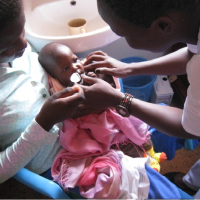
Treating uncomplicated malaria in children: do child‐friendly formulations of medicines work better than usual tablet formulations?
What is the aim of this review?
We wanted to find out about the potential benefits and harms of child‐friendly formulations of artemisinin‐based combination therapy (ACT) to treat uncomplicated malaria in children. We searched for studies that investigated the use of child‐friendly formulations of ACTs, compared with the usual ACT tablet formulations, to treat uncomplicated malaria in children aged under 14 years. We looked for randomized controlled studies, in which the treatments the children received were decided at random. This type of study usually gives the most reliable evidence about the effects of a treatment. We found three relevant studies of two child‐friendly formulations.
Key messages
Child‐friendly formulations of ACT probably work as well as crushed tablets to treat uncomplicated malaria in children, and probably cause fewer unwanted effects.
What was studied in this review?
Malaria is a tropical disease spread by mosquitoes infected with Plasmodium parasites. The most common, and most serious, type of malaria is caused by Plasmodium falciparum. This parasite causes high levels of illness and death, particularly in young children in regions where malaria is widespread.
Malaria can be a mild illness, but is sometimes severe and life‐threatening if not treated soon enough or with the right medicines.
Medicines based on artemisinin, a compound derived from a plant (Artemisia annua), are commonly taken by mouth (orally) to treat malaria in combination with other drugs. The World Health Organization recommends treating uncomplicated malaria with oral artemisinin‐based combination therapy (called ACT).
Oral ACT tablets are often crushed to help make them easier for children to swallow. New formulations of oral ACTs have been developed especially for children, such as syrups, and granules, powders or tablets that can be dissolved in water, and which may be flavoured.
What are the main results of this review?
We found three relevant studies in 1306 children (aged 6 months to 11 years) with uncomplicated malaria. The studies were conducted in sub‐Saharan Africa between 2006 and 2015. All studies were funded by pharmaceutical companies that made child‐friendly formulations of the ACTs.
The studies compared crushed ACT tablets to child‐friendly formulations of ACTs: these were dissolvable tablets of artemether‐lumefantrine or dihydroartemisinin‐piperaquine, or artemether‐lumefantrine syrup.
We were interested in:
· whether children remained cured of malaria after 28 days (measured by absence of Plasmodium parasites in the blood); and
· whether the medicines caused any unwanted effects.
None of the studies looked at how any of the medicine formulations were accepted by children.
There may be little or no difference between the child‐friendly formulations of ACTs (dissolvable tablets or syrup) and the usual crushed tablets for how many children:
· were successfully treated after 28 days; or
· experienced serious unwanted effects.
The crushed ACT tablets and the child‐friendly formulations successfully treated most cases of uncomplicated malaria. After 28 days the rates of treatment failure were similar in both groups. On average, 59 of every 1000 children taking crushed ACT tablets and 62 of every 1000 children taking dissolvable tablets would still have Plasmodium infection (2 studies; 1139 children).
Similar numbers of serious unwanted effects were reported for the usual crushed tablets and the dissolvable tablets (2 studies; 1197 children) or syrup (1 study; 267 children), therefore differences as a result of the formulation are unlikely.
A dissolvable tablet probably reduces unwanted effects of the medicine, including vomiting (throwing up), compared with the usual crushed tablets. Children taking dissolvable tablets had fewer unwanted effects associated with the medicine (139 of every 1000 children) than those taking crushed tablets (178 of every 1000 children).
There was no difference in the number of unwanted effects found in the study with the syrup formulation compared with the usual crushed tablets.
Our confidence in our results is low to moderate. The results come from a small number of studies. All studies were supported by manufacturers of the child‐friendly formulations, which could have affected how the studies were designed, conducted, and reported.
How up‐to‐date is this review?
We searched for studies that had been published up to 11 December 2019.
- Read the full Review on the Cochrane Library
The editorial base of the Cochrane Infectious Diseases Group is funded by UK aid from the UK government for the benefit of low- and middle-income countries (project number 300342-104). The views expressed do not necessarily reflect the UK government’s official policies.
